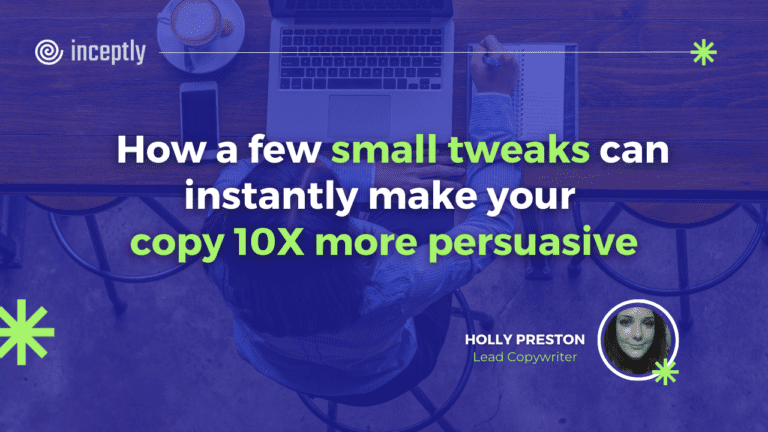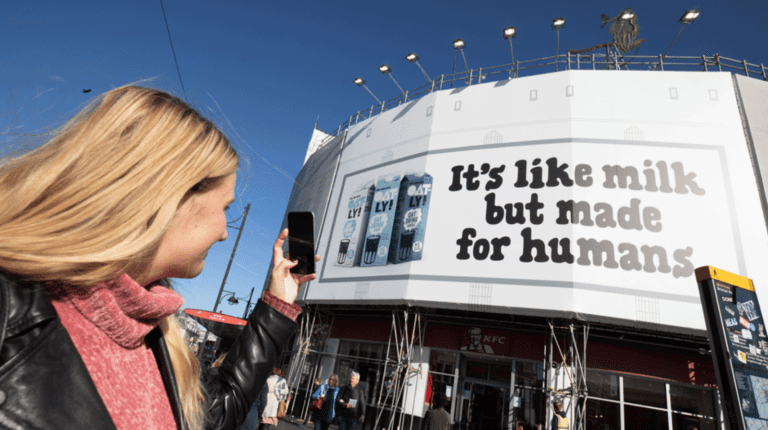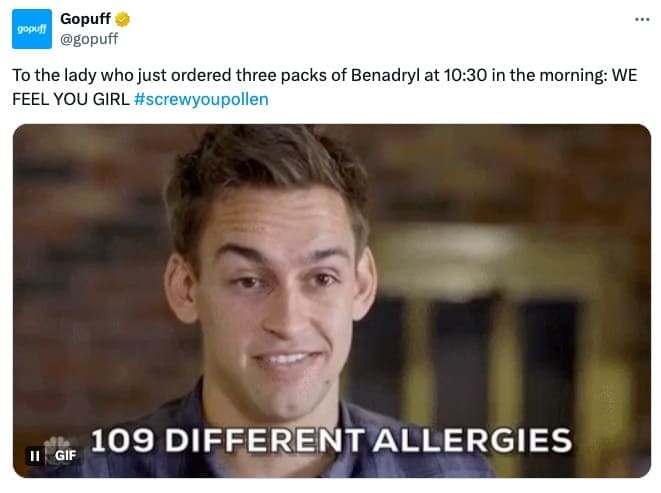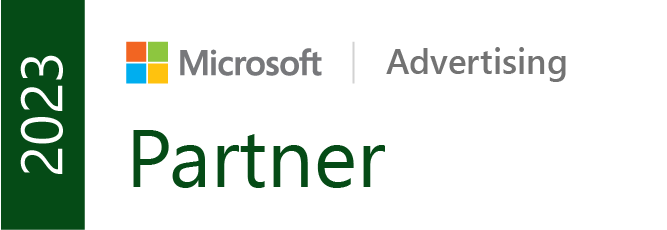
Hey guys, Holly here!
I’ve worked as the lead copywriter for Inceptly for many years, and when putting together this article, I kept coming back to these simple tips that have helped me (and countless clients) the most. They’re quick and easy to implement, don’t cost a penny, and I promise they’ll improve your writing immediately:
1. Always read your copy out loud
When you actually speak your words, you’ll instantly catch phrases that sound unnatural or robotic. If you stumble while reading, your readers will stumble while reading. The natural conversation has a rhythm—when something breaks that rhythm, that’s your signal to rewrite.
2. The intention check
For every line you write, ask yourself: “Is this adding to my core message, or is it just taking up space?”
✅ If it strengthens your message: Keep it
❌ If it’s neutral or distracting: Cut it
🚫 If it weakens your point: Remove it immediately
3. The art of conversational copywriting
Now, for the main focus of this article, here is a third essential element that will transform your writing: The art of conversational copywriting. While we all have conversations every day, crafting copy that feels natural while driving results takes practice. Hopefully, this article will help you nail it.
Want to brainstorm with our team on new ways to scale your business with YouTube Ads (and other performance video platforms)?
Join us for a free YouTube ad brainstorming session👇
Key stats ⏳
Companies that used conversational marketing saw 20% more sales opportunities, 10% more average order value, and 5-10% more customer retention.1
Engaged prospects are 70% more likely to convert into marketing-qualified leads when using conversational marketing approaches.2
79% of companies say live chat increases customer loyalty and sales.3
52% of customers would buy again from a company that offers live chat.4
A study revealed that over 50% of businesses using conversational marketing solutions experienced increased sales productivity.5
One copywriter reported that across over 1,124+ projects, their conversational copywriting drove a 55% increase in on-page conversion rates and an 84% increase in quality sales-qualified leads.6
What makes copy conversational?
Think of it as the difference between a scripted sales pitch and helpful advice from a friend. Conversational copy mirrors natural dialogue, making readers feel like they’re part of a one-on-one conversation rather than being marketed to. It’s not about being casual—it’s about being human.
Traditional vs. conversational copy: See the difference
Conversational copy isn’t just about using casual language—it’s about crafting messaging that feels effortless, relatable, and engaging while maintaining clarity and impact. Let’s explore how brands like Oatly and Banquist use this approach to stand out in their industries.
1. Oatly’s approach: Standing out in the dairy alternative market
Traditional: “Our plant-based milk alternative provides essential nutrients.”
Conversational: “It’s like milk, but made for humans.”
✅ Why this works: Oatly’s bold, simple, and slightly cheeky tagline instantly sets it apart from traditional dairy marketing. Instead of listing product benefits in a clinical way, it invites conversation and intrigues the reader.
📌 The impact:
This slogan sparked curiosity and controversy, leading to massive brand awareness and even legal disputes with dairy brands, which Oatly leveraged as free PR.
Their branding consistently challenges the dairy industry’s messaging, positioning their product as a more ethical and sustainable choice.
Oatly’s bold, conversational branding played a key role in helping them stand out in a saturated market, supporting their rapid revenue growth from $200M in 2019 to over $700M by 2022.7
2. GoPuff’s approach: Using humor and relatability to connect with customers
Traditional: “We deliver convenience store items straight to your door.”
Conversational: “Three packs of Benadryl at 10:30 AM? We’ve all been there. #ScrewYouPollen”
✅ Why this works: GoPuff’s ad doesn’t just promote their service—it taps into a shared experience that allergy sufferers instantly relate to. Instead of saying, “We deliver medicine fast,” they turn an everyday inconvenience into a humorous, engaging message.
📌 The impact:
The self-aware, cheeky tone makes the ad feel less like marketing and more like a relatable moment.
The hashtag #ScrewYouPollen encourages engagement, making it easy for customers to share their allergy struggles while reinforcing GoPuff’s brand personality.
This kind of casual, empathetic messaging helps GoPuff stand out in the crowded delivery service market, creating brand affinity and repeat customers.
💡 Key takeaway: GoPuff’s conversational approach transforms a simple ad into a moment of shared understanding. They don’t just sell convenience—they connect with customers on a personal level. That’s what makes their copy so effective. 🚀
Why it works: The psychology
When we encounter natural, friendly language, something interesting happens—our guard drops. We process the information differently than we do formal marketing messages.
According to Stanford research, people are significantly more likely to remember information presented in story form compared to standalone facts or statistics, with one study finding that 63% of people remembered stories while only 5% recalled individual statistics.8
Key techniques for mastering conversational copywriting
1. Understand your audience 🎯
Research their tone, speech patterns, and preferences.
Mirror their language for familiarity and engagement.
Example: A fitness brand targeting young professionals might say, “Feeling sluggish after back-to-back Zoom calls? Let’s fix that.”
2. Be concise ✂️
Use short sentences to prevent reader fatigue.
Cut unnecessary words and jargon.
Example: Instead of “Optimize your workflow,” say “Make work easier.”
3. Use active voice 🚀
Writing in an active voice makes your message clear, direct, and engaging. Passive voice, on the other hand, can create distance and reduce impact.
Direct and impactful writing enhances readability.
Example:
✅ “Our team created this tool to save you time.” (Active)
❌ “This tool was created to save time by our team.” (Passive)
Why it matters: Studies show that active voice improves comprehension and retention, making your message more persuasive.
4. Inject personality 🎭
Showcase your brand’s unique voice.
Authenticity fosters trust and relatability.
Example: Oatly’s tagline: “It’s like milk, but made for humans.”
5. Pose questions❓
Engage readers by inviting mental participation.
Example: Instead of “Our software makes marketing easier,” ask “Tired of spending hours scheduling posts?”
6. Use storytelling 📖 – Why it’s essential in conversational copy
Stories aren’t just engaging—they’re scientifically proven to make information stick. According to research from Stanford University, stories are 22 times more memorable than standalone facts!9
Here’s why storytelling is so effective in copywriting:
✅ Triggers emotion & connection – People don’t just remember stories; they feel them. Emotionally driven stories increase brand loyalty and create a deeper connection.
✅ Makes complex information easier to digest – Instead of listing features and benefits, stories contextualize your message in a way that’s relatable and understandable.
✅ Increases engagement & persuasion – People are wired to pay attention to narratives. A compelling story holds attention better than dry facts.
✅ Encourages action – A great story naturally guides the reader toward a conclusion, making CTAs feel seamless instead of forced.
💬 Example of storytelling in conversational copy:
❌ Traditional copy: “Our software helps you manage tasks efficiently.”
✅ Conversational storytelling: “Sarah used to waste hours juggling emails and to-do lists. Now? She finishes work by 4 PM, thanks to [product name].”
💡Key takeaway: Incorporating storytelling into conversational copy makes your messaging more engaging, persuasive, and memorable—just like a great chat with a friend. 🚀
7. Add calls-to-action (CTAs) naturally 🔗
Hard-sell CTAs like “BUY NOW!” can feel pushy. Instead, blend them into the conversation:
✔ Frame it as a next step – “Curious to see it in action? Click here.”
✔ Make it about the reader – “Want an easier way to manage your tasks? Let’s get started.”
✔ Use a soft-close approach – “If this sounds like what you need, let’s chat.”
💡 Key takeaway: Your CTA should feel like a natural extension of the conversation, not a sales pitch.
Measuring success: How to track the impact of conversational copy
Conversational copy is great—but how do you know it’s working? Measuring success is crucial to refining and improving your approach.
Key metrics to track:
📩 Email open rates – Are people opening your emails more frequently?
📊 Click-through rates (CTR) – Are they engaging with your content?
⏳ Time on page – Are they spending more time reading?
💰 Conversions – Are your changes leading to more sales, sign-ups, or leads?
🗣️ Qualitative feedback – Are customers engaging more, leaving positive comments, or responding naturally?
📌 Tip: Run A/B tests with traditional vs. conversational copy to see what actually resonates with your audience (Copyhackers).
When NOT to use conversational copy
Conversational copy is powerful, but it doesn’t work everywhere.
❌ Highly technical writing – Industries like medicine, law, or finance may require precise, formal language.
❌ Serious or sensitive topics – Crisis communications or legal documents may need a more formal tone.
❌ When your audience prefers formality – Luxury or corporate audiences may expect a more polished approach.
📌 Tip: Know your audience—test different tones and see what resonates best.
Your turn to take action
We’ve covered a lot, but you don’t need to transform all your copy overnight. Start with those two simple checks: read your copy aloud and check every line’s intention. Then pick one piece of content and make it more conversational.
Want a quick win? Choose an important email or webpage, record yourself explaining its message to a friend, and use that natural language to improve your written copy. Simple, effective, and it works.
Looking forward
Marketers today are bombarded with formulas, templates, and AI-generated scripts. But the secret to standing out isn’t following another framework—it’s bringing it back to basics. Speak like a human, write like you talk, and connect with your audience the way real people do. That’s how you break through the noise.🗣️
Want to brainstorm with our team on new ways to scale your business with YouTube Ads (and other performance video platforms)?
Join us for a free YouTube ad brainstorming session:
Want more content like this?
Don’t miss out on the latest news and updates from the world of Direct Response advertising! Subscribe to our newsletter today 👇

Holly Preston, Lead Copywriter
Holly is behind most of Inceptly's successful creatives, supporting the team with her experience and imagination, making her an invaluable asset to Inceptly.
Like this post? Let's continue the conversation!
Get in touch with us by shooting us a quick email or tagging us on LinkedIn or Instagram, and sharing your thoughts. Your feedback helps us keep our blog relevant and interesting.
Get Our Newsletter
Need Help?
Get in touch with us for an insightful evaluation of your ads + actionable tips to help amp up your direct response revenue





